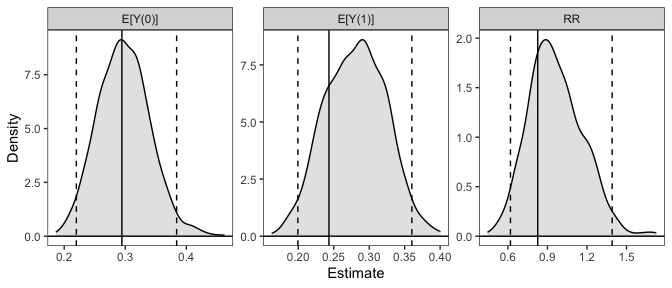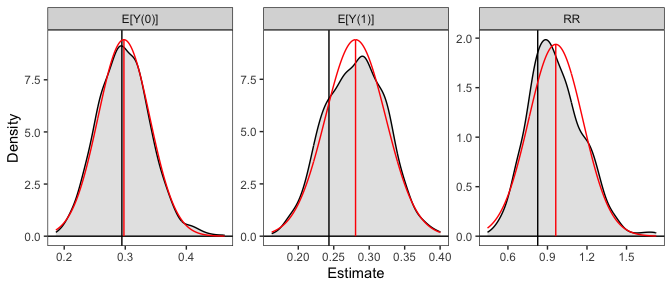clarify:
Simulation-Based Inference for Regression Modelsclarify implements simulation-based inference for functions
of model parameters, such as average marginal effects and predictions at
representative values of the predictors. See the clarify website for documentation and
other examples, and see Greifer et al. (2025) for the
paper describing the package (also available at
vignette("clarify")). clarify was designed to
replicate and expand on functionality previously provided by the
Zelig package.
clarify can be installed from CRAN using
install.packages("clarify")You can install the development version of clarify from GitHub with
install.packages("remotes")
remotes::install_github("iqss/clarify")Below is an example of performing g-computation for the average
treatment effect on the treated (ATT) after logistic regression to
compute the average causal risk ratio and its confidence interval. First
we load the data (in this case the lalonde dataset from
MatchIt) and fit a logistic regression using functions outside
of clarify:
library(clarify)
data("lalonde", package = "MatchIt")
# Fit the model
fit <- glm(I(re78 > 0) ~ treat + age + educ + race + married +
nodegree + re74 + re75,
data = lalonde, family = binomial)Next, to estimate the ATT risk ratio, we simulate coefficients from their implied distribution and compute the effects of interest in each simulation, yielding a distribution of estimates that we can summarize and use for inference:
# Simulate coefficients from a multivariate normal distribution
set.seed(123)
sim_coefs <- sim(fit)
# Marginal risk ratio ATT, simulation-based
sim_est <- sim_ame(sim_coefs,
var = "treat",
subset = treat == 1,
contrast = "RR",
verbose = FALSE)
sim_est
#> A `clarify_est` object (from `sim_ame()`)
#> - Average adjusted predictions for `treat`
#> - 1000 simulated values
#> - 3 quantities estimated:
#> E[Y(0)] 0.6831
#> E[Y(1)] 0.7568
#> RR 1.1078
# View the estimates, confidence intervals, and p-values
summary(sim_est, null = c(`RR` = 1))
#> Estimate 2.5 % 97.5 % P-value
#> E[Y(0)] 0.683 0.592 0.754 .
#> E[Y(1)] 0.757 0.693 0.807 .
#> RR 1.108 0.979 1.289 0.12
# Plot the resulting sampling distributions
plot(sim_est)
Below, we provide information on the framework clarify uses
and some other examples. For a complete vignette, see
vignette("clarify").
Simulation-based inference is an alternative to the delta method and bootstrapping for performing inference on quantities that are functions of model parameters. It involves simulating model coefficients from their multivariate distribution using their estimated values and covariance from a single model fit to the original data, computing the quantities of interest from each set of model coefficients, and then performing inference using the resulting distribution of the estimates as their sampling distribution. Confidence intervals can be computed using the percentiles of the resulting sampling distribution, and p-values can be computed by inverting the confidence intervals. Alternatively, if the resulting sampling distribution is normally distributed, its standard error can be estimated as the standard deviation of the estimates and normal-theory Wald confidence intervals and p-values can be computed. The methodology of simulation-based inference is explained in King, Tomz, and Wittenberg (2000) and Herron (1999).
clarify was designed to provide a simple, general interface
for simulation-based inference and includes a few convenience functions
to perform common tasks like computing average marginal effects. The
primary functions of clarify are sim(),
sim_apply(), summary(), and
plot(). These work together to create a simple workflow for
simulation-based inference.
sim() simulates model parameters from a fitted
modelsim_apply() applies an estimator to the simulated
coefficients, or to the original object but with the new coefficients
insertedsummary() produces confidence intervals and p-values
for the resulting estimatesplot() produces plots of the simulated sampling
distribution of the resulting estimatesThere are also some wrappers for sim_apply() for
performing some common operations: sim_ame() computes the
average marginal effect of a variable, mirroring
marginaleffects::avg_predictions() and
marginaleffects::avg_slopes(); sim_setx()
computes predictions at typical values of the covariates and differences
between them, mirroring Zelig::setx() and
Zelig::setx1(); and sim_adrf() computes
average dose-response functions. clarify also offers support
for models fit to multiply imputed data with the misim()
function.
In the example above, we used sim_ame() to compute the
ATT, but we could have also done so manually using
sim_apply(), as demonstrated below:
# Write a function that computes the g-computation estimate for the ATT
ATT_fun <- function(fit) {
d <- subset(lalonde, treat == 1)
d$treat <- 1
p1 <- mean(predict(fit, newdata = d, type = "response"))
d$treat <- 0
p0 <- mean(predict(fit, newdata = d, type = "response"))
c(`E[Y(0)]` = p0, `E[Y(1)]` = p1, `RR` = p1 / p0)
}
# Apply that function to the simulated coefficient
sim_est <- sim_apply(sim_coefs, ATT_fun, verbose = FALSE)
sim_est
#> A `clarify_est` object (from `sim_apply()`)
#> - 1000 simulated values
#> - 3 quantities estimated:
#> E[Y(0)] 0.6831
#> E[Y(1)] 0.7568
#> RR 1.1078
# View the estimates, confidence intervals, and p-values;
# they are the same as when using sim_ame() above
summary(sim_est, null = c(`RR` = 1))
#> Estimate 2.5 % 97.5 % P-value
#> E[Y(0)] 0.683 0.592 0.754 .
#> E[Y(1)] 0.757 0.693 0.807 .
#> RR 1.108 0.979 1.289 0.12
# Plot the resulting sampling distributions
plot(sim_est, reference = TRUE, ci = FALSE)
The plot of the simulated sampling distribution indicates that the sampling distribution for the risk ratio is not normally distributed around the estimate, indicating that the delta method may be a poor approximation and the asymmetric confidence intervals produced using the simulation may be more valid. Note that the estimates are those computed from the original model coefficients; the distribution is used only for computing confidence intervals, in line with recommendations by Rainey (2023).
If we want to compute the risk difference, we can do that using
transform() on the already-produced output:
#Transform estimates into new quantities of interest
sim_est <- transform(sim_est, `RD` = `E[Y(1)]` - `E[Y(0)]`)
summary(sim_est, null = c(`RR` = 1, `RD` = 0))
#> Estimate 2.5 % 97.5 % P-value
#> E[Y(0)] 0.6831 0.5925 0.7543 .
#> E[Y(1)] 0.7568 0.6934 0.8067 .
#> RR 1.1078 0.9789 1.2888 0.12
#> RD 0.0737 -0.0155 0.1742 0.12We can also use clarify to compute predictions and first
differences at set and typical values of the predictors, mimicking the
functionality of Zelig’s setx() and
setx1() functions, using sim_setx():
# Predictions across age and treat at typical values
# of the other predictors
sim_est <- sim_setx(sim_coefs,
x = list(age = 20:50, treat = 0:1),
verbose = FALSE)
#Plot of predicted values across age for each value of treat
plot(sim_est)
See vignette("Zelig", package = "clarify") for more
examples of translating a Zelig-based workflow into one that
uses clarify to estimate the same quantities of interest.
clarify offers parallel processing for all estimation
functions to speed up computation. Functionality is also available for
the analysis of models fit to multiply imputed data. See
vignette("clarify") for more details.